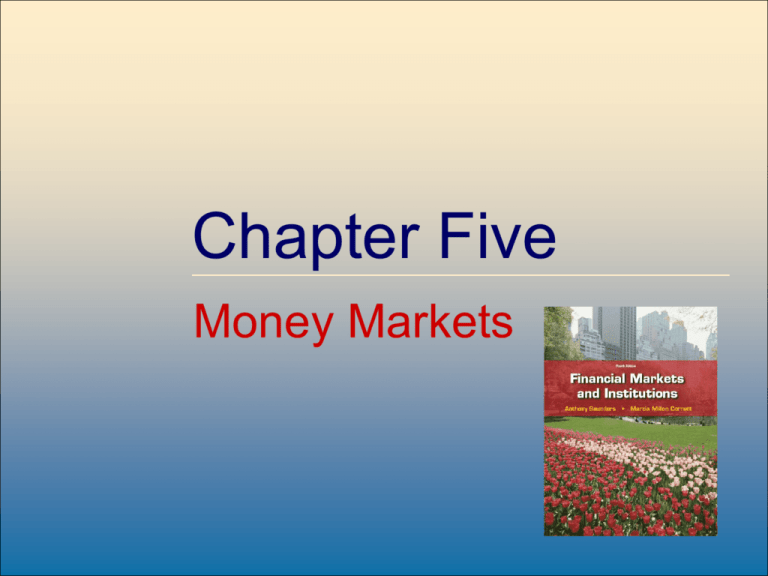
Chapter Five
Money Markets
McGraw-Hill/Irwin
5-1
©2009, The McGraw-Hill Companies, All Rights Reserved
Money Markets
• Liquid funds flow between short-term borrowers and
lenders through money markets
• Money markets involve debt instruments with original
maturities of one year or less
• Money market debt
– issued by high-quality (i.e., low default risk) economic units that
require short-term funds
– purchased by economic units that have excess short-term funds
• Money market instruments have active secondary
markets
McGraw-Hill/Irwin
5-2
©2009, The McGraw-Hill Companies, All Rights Reserved
Money Market Yields
• Some money market instruments are bought and
sold on a discount basis (e.g., Treasury bills and
commercial paper)
• Discount yields (idy) use a 360-day year
( Pf P0 ) 360
idy
Pf
h
Pf = the face value of the security
P0 = the discount price of the security
h = the number of days until maturity
McGraw-Hill/Irwin
5-3
©2009, The McGraw-Hill Companies, All Rights Reserved
Money Market Yields
• Compare discount securities to U.S. Treasury
bonds with bond equivalent yields (ibey)
( Pf P0 ) 365
idy
P0
h
• Convert bond equivalent yields into effective
annual returns (EAR)
ibey
EAR 1
365 / h
McGraw-Hill/Irwin
5-4
365/ h
1
©2009, The McGraw-Hill Companies, All Rights Reserved
Money Market Yields
• Money market securities that pay interest only at maturity
use single-payment yields (ispy) (e.g., jumbo CDs and fed
funds)
– since ispy uses a 360 day year, compare to bonds by converting to a
365 day year
ibey ispy (365 / 360)
– to convert a single-payment yield to an effective annual return
365 / 360
EAR 1 ispy
365
/
h
McGraw-Hill/Irwin
5-5
365/ h
1
©2009, The McGraw-Hill Companies, All Rights Reserved
Money Market Instruments
•
•
•
•
•
•
Treasury bills (T-bills)
Federal funds (fed funds)
Repurchase agreements (repos or RP)
Commercial paper (CP)
Negotiable certificates of deposit (CD)
Banker acceptances (BA)
McGraw-Hill/Irwin
5-6
©2009, The McGraw-Hill Companies, All Rights Reserved
Treasury Bills (T-Bills)
• T-Bills are short-term debt obligations
issued by the U.S. government
• The Federal Reserve buys and sells T-bills
to implement monetary policy
• T-bills are virtually default risk free, are
highly liquid, and have little interest rate
risk
McGraw-Hill/Irwin
5-7
©2009, The McGraw-Hill Companies, All Rights Reserved
T-Bill Auctions
• 13- and 26-week T-bills are auctioned weekly
• Bids are submitted by government securities
dealers, financial and nonfinancial corporations,
and individuals
• Bids can be competitive or noncompetitive
– competitive bids specify the bid price and the desired
quantity of T-bills
– noncompetitive bidders get preferential allocation and
agree to pay the lowest price of the winning
competitive bids
McGraw-Hill/Irwin
5-8
©2009, The McGraw-Hill Companies, All Rights Reserved
T-Bill Auctions
Noncompetitive Bids
Bid Price
1
SC
2
ST
3
4
5
Stop-out
price (PNC)
6
7
Quantity of
T-bills
McGraw-Hill/Irwin
5-9
©2009, The McGraw-Hill Companies, All Rights Reserved
The Secondary Market for T-Bills
• The secondary market for T-bills is the largest of
any U.S. money market instrument
• 22 primary dealers “make” a market in T-bills by
buying the majority sold at auction and by
creating an active secondary market
– primary dealers trade for themselves and for customers
– T-bill purchases and sales are book-entry transactions
conducted over Fedwire
• T-Bills are sold on a discount basis
McGraw-Hill/Irwin
5-10
©2009, The McGraw-Hill Companies, All Rights Reserved
T-Bill Prices
• T-Bill prices can be calculated from quotes (e.g., from The
Wall Street Journal) by rearranging the discount yield
equation
h
P0 Pf iT Bill (dy )
Pf
360
• Or by rearranging the bond equivalent yield equation
P0
McGraw-Hill/Irwin
Pf
h
1
365 / iT Bill (bey )
5-11
©2009, The McGraw-Hill Companies, All Rights Reserved
Federal Funds
• The federal funds (fed funds) rate is the target rate
in the conduct of monetary policy
• Fed fund transactions are short-term (mostly
overnight) unsecured loans
• Banks with excess reserves lend fed funds, while
banks with deficient reserves borrow fed funds
• Fed funds are single-payment loans and thus use
single-payment yields
McGraw-Hill/Irwin
5-12
©2009, The McGraw-Hill Companies, All Rights Reserved
Repurchase Agreement
• A repurchase agreement (repo or RP) is the sale of
a security with an agreement to buy the security back
at a set price in the future
• Repos are short-term collateralized loans (typical
collateral is U.S. Treasury securities)
• A reverse repurchase agreement is the opposite side
of a repo (i.e., it is the purchase of a security with an
agreement to sell it back in the future)
McGraw-Hill/Irwin
5-13
©2009, The McGraw-Hill Companies, All Rights Reserved
Repurchase Agreement
• The yield on repurchase agreements (iRA) uses a
360-day year like the discount rate, but uses the
current price in the denominator like the bond
equivalent yield
( Pf P0 ) 360
iRA
P0
h
Pf = the repurchase price of the security
P0 = the selling price of the security
h = the number of days until the repo matures
McGraw-Hill/Irwin
5-14
©2009, The McGraw-Hill Companies, All Rights Reserved
Commercial Paper
• Commercial paper (CP) is the largest money market in
terms of dollars outstanding
• CP is unsecured short-term corporate debt issued to raise
short-term funds (e.g., for working capital)
• Generally sold in large denominations (e.g., $100,000 to
$1 million) with maturities between 1 and 270 days
• CP is usually sold to investors indirectly through brokers
and dealers (approximately 85% of the time)
• CP is usually held by investors until maturity and has no
active secondary market
• Yields are quoted on a discount basis (like T-bills)
McGraw-Hill/Irwin
5-15
©2009, The McGraw-Hill Companies, All Rights Reserved
Negotiable Certificate of Deposit
• A negotiable certificate of deposit (CD) is a
bank-issued time deposit that specifies the interest
rate and the maturity date
• CDs are bearer instruments and thus are salable in
the secondary market
• Denominations range from $100,000 to $10
million; $1 million being the most common
• Often purchased by money market mutual funds
with pools of funds from individual investors
McGraw-Hill/Irwin
5-16
©2009, The McGraw-Hill Companies, All Rights Reserved
Banker’s Acceptance
• A Banker’s Acceptance (BA) is a time draft payable to
a seller of goods with payment guaranteed by a bank
• Used in international trade transactions to finance trade
in goods that have yet to be shipped from a foreign
exporter (seller) to a domestic importer (buyer)
• Foreign exporters prefer that banks act as payment
guarantors before sending goods to importers
• Banker’s acceptances are bearer instruments and thus
are salable in secondary markets
McGraw-Hill/Irwin
5-17
©2009, The McGraw-Hill Companies, All Rights Reserved
Money Market Participants
•
•
•
•
•
•
•
•
The U.S. Treasury
The Federal Reserve
Commercial banks
Money market mutual funds
Brokers and dealers
Corporations
Other financial institutions
Individuals
McGraw-Hill/Irwin
5-18
©2009, The McGraw-Hill Companies, All Rights Reserved
International Money Markets
• U.S. dollars held outside the U.S. are tracked among
multinational banks in the Eurodollar market
• The rate offered for sale on Eurodollar funds is the
London Interbank Offered Rate (LIBOR)
• Eurodollar Certificates of Deposits are U.S. dollar
denominated CDs held in foreign banks
• Eurocommercial paper (Euro-CP) is issued in
Europe and can be in local currencies or U.S. dollars
McGraw-Hill/Irwin
5-19
©2009, The McGraw-Hill Companies, All Rights Reserved






